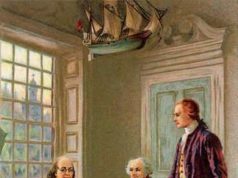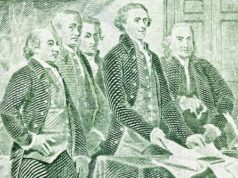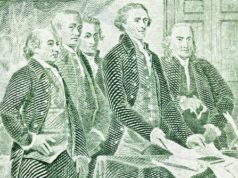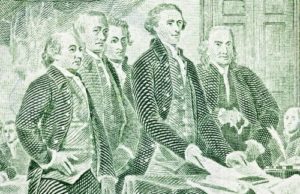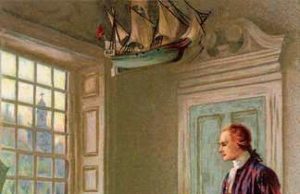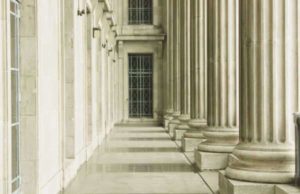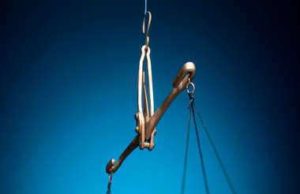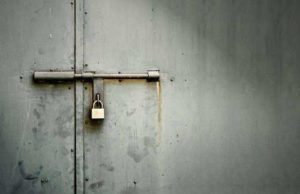Table of Contents
- 0.1 Education and Early Political Life
- 0.2 The Stamp Act and Early Opposition to British Policies
- 0.3 The Continental Congress and the Declaration of Rights and Grievances
- 0.4 The Second Continental Congress and the Declaration of Independence
- 0.5 Later Life and Legacy
- 0.6 Conclusion
- 1 Founding Father: John Dickinson
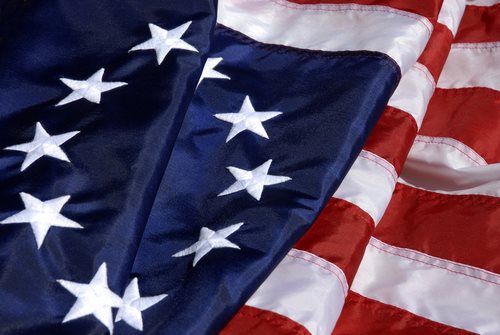
John Dickinson is one of the lesser-known figures of American history who played a significant role in shaping the future of the United States of America. Born on November 8, 1732, in Talbot County, Maryland, Dickinson grew up in a family of wealthy tobacco planters. He was the second son of Samuel Dickinson and Mary Cadwalader, and he was of Welsh and English descent. Although he was born in Maryland, his family moved to Kent County, Delaware, when he was still a child.
Education and Early Political Life
Dickinson received his primary education at home, but his father also hired tutors to teach him and his siblings. He later attended the Reverend Francis Alison’s academy in New London, Pennsylvania, where he was exposed to the writings of English philosophers such as John Locke and Algernon Sidney. Dickinson then went on to study at the College of Philadelphia, now the University of Pennsylvania, where he received his Bachelor of Arts in 1753 and his Master of Arts in 1756.
After completing his education, Dickinson returned to Delaware, where he entered politics. He was elected to the Delaware General Assembly in 1760, where he served as speaker from 1761 to 1762. In 1764, he was elected to the Pennsylvania Assembly, where he served until 1776.
The Stamp Act and Early Opposition to British Policies
In 1765, the British Parliament passed the Stamp Act, which imposed a tax on all legal documents, newspapers, and printed matter in the American colonies. This act was widely opposed in the colonies, and Dickinson was one of its most vocal opponents. He wrote a series of essays under the pen name “A Farmer” that were published in the Pennsylvania Chronicle. In these essays, Dickinson argued that the colonies had the right to govern themselves and that the British government was violating their rights by imposing taxes without their consent.
These essays made Dickinson a well-known figure in the colonies and earned him a reputation as a leading thinker and writer on political issues. They were widely read and reprinted in other newspapers throughout the colonies.
In 1767, the British government passed the Townshend Acts, which placed taxes on a variety of goods, including glass, paper, and tea. Dickinson again opposed these measures and wrote a series of letters to newspapers and political leaders arguing that the colonies should boycott British goods in protest.
The Continental Congress and the Declaration of Rights and Grievances
In 1774, delegates from twelve of the thirteen colonies met in Philadelphia for the first Continental Congress. Dickinson was one of the delegates from Pennsylvania and was a prominent figure in the Congress. He helped draft the Declaration of Rights and Grievances, which asserted the rights of the colonies to govern themselves and protested against British policies.
However, Dickinson was also a moderate who hoped to avoid a complete break with Britain. He opposed calls for independence and instead advocated for reconciliation with Britain. He believed that the colonies could maintain their rights and freedoms while remaining part of the British Empire.
The Second Continental Congress and the Declaration of Independence
In 1775, the colonies went to war with Britain, and the Second Continental Congress was formed. Dickinson was again a prominent figure in the Congress and continued to advocate for reconciliation with Britain. He opposed the Declaration of Independence and refused to sign it, feeling that it would lead to a long and bloody war.
However, Dickinson continued to serve his country during the Revolution in other ways. He was a member of the Committee of Safety in Pennsylvania and was responsible for raising troops and supplies for the Continental Army. He also served as a brigadier general in the Pennsylvania militia from 1777 to 1783.
Later Life and Legacy
After the war, Dickinson was elected to the Constitutional Convention in 1787. He was one of the most vocal advocates for a strong central government and helped draft the United States Constitution. However, he refused to sign the Constitution over concerns about the balance of power between the states and the federal government.
Dickinson retired from politics after the Constitutional Convention and returned to private life. He died on February 14, 1808, at the age of 75. Although he is not as well-known as some of the other founding fathers, such as George Washington or Thomas Jefferson, Dickinson played an important role in American history. His writings and political activities helped shape the course of the American Revolution and the formation of the new United States of America.
Conclusion
John Dickinson was a complex figure who played a significant role in American history. He was a patriot who fought for the rights of the colonies and helped draft the United States Constitution. However, he was also a moderate who hoped for reconciliation with Britain and opposed the Declaration of Independence.
Despite his disagreements with some of the other founding fathers, Dickinson was highly respected by his peers. Benjamin Rush, a fellow signer of the Declaration of Independence, said of Dickinson, “He was the very soul of modesty, benevolence, and sincerity. His manners were those of a true gentleman, simple, unostentatious, and respectful to all.”
Today, Dickinson is perhaps best remembered for his writings as “A Farmer” and his role in the Continental Congress and the Constitutional Convention. His legacy as a patriot and statesman continues to be celebrated by historians and political scholars who study the history of the early United States of America.
Founding Father: John Dickinson
John Dickinson was born on November 18, 1732 at the Crosiadore estate, near Trappe in Talbot County, Maryland. John Dickinson was the second son of Samuel Dickinson, who was a prosperous farmer, and his second wife, Mary Dickinson. In 1740, John Dickinson’s family moved from Maryland to Kent County, Delaware. Here, private tutors were hired to educate John Dickinson. In 1750, he started to study law in Philadelphia with John Moland. In 1753, John Dickinson travelled to England in order to continue his education at London’s Middle Temple. After four years, he came back to Philadelphia and quickly became a prominent lawyer. In 1770, John Dickinson married Mary Norris, the daughter of a wealthy merchant.
By this time, John Dickinson’s superior talents and education had placed him into politics. In 1760, Dickinson had already served in the assembly of the Three Lower Counties, where he was the speaker. Combining his Delaware and Pennsylvania careers, he won a seat as a member in the Pennsylvania assembly in 1762 and sat for another term in 1764. John Dickinsona became a leader of the conservative group in the political battles of the colonies. His defense of the governor against the group led by Benjamin Franklin damaged his popularity but earned him respect from others for his integrity. Nevertheless, in 1764 he lost his legislative seat.
Meantime, the tension between the colonies and Great Britain had gotten stronger and John Dickinson had become a prominent Revolutionary thinker. In the debates regarding the Stamp Act of 1765, he played a vital part. The same year, John Dickinson wrote “The Late Regulations Respecting British Colonies Considered”, which was a very influential pamphlet that begged Americans to fight for repeal of the act by putting pressure on British merchants. Because of this, the Pennsylvania legislature made him a Pennsylvania delegate to the Stamp Act Congress.
Between 1767 and 1768, John Dickinson wrote a set of newspaper articles in the Pennsylvania Chronicle that later was collectively called Letters from a Farmer in Pennsylvania. These letters attacked the taxation policy of the British and urged the colonies to resist these unjust laws. The letters also emphasized the potential of a peaceful resolution. Because the letters were extremely popular in the colonies, John Dickinson was given an honorary LL.D. from the College of New Jersey along with public thanks during a meeting in Boston. In 1768, in response to the Townshend Duties, John Dickinson championed rigorous colonial resistance through the use of non-exportation and non-importation agreements.
In 1771, John Dickinson returned to the Pennsylvania legislature, where he drafted a petition intended for the king which was unanimously approved. However, because of his continuous opposition to the use of force, by 1774 he lost a lot of his popularity. He was extremely critical of the tactics used by New England leaders that year and refused to support any aid requested by Boston after the Intolerable Acts, although he sympathized with the plight of Boston. Reluctantly, John Dickinson was pushed into the Revolutionary fray. In 1774 he became chairman of the Philadelphia committee of correspondence and also briefly sat as a representative from Pennsylvania in the First Continental Congress.
Throughout 1775, John Dickinson supported the Whigs, but he continued to work for peace. Dickenson drew up many petitions questioning redress of grievances from the king. At the same time, he also chaired a Philadelphia committee of safety and defense and also held a colonelcy in the very first battalion recruited to defend the city of Pennsylvania.
After Lexington and Concord, John Dickinson continued to wish for a peaceful solution. During the Second Continental Congress from 1775 to 1776, he drew up a Declaration of the Causes of Taking Up Arms as the representative from Pennsylvania. In the Pennsylvania assembly, he also drafted an authorization to send some delegates in 1776 to Congress. This draft directed them to look for redress of grievances, but also ordered them to oppose the separation of the American colonies from Great Britain.
By this time, John Dickinson’s moderate position had made him a member of the minority. In Congress, Dickinson voted in 1776 against the Declaration of Independence and. He refused to sign it. Even so, he became one of two contemporary congressional members, the other being Thomas McKean, who enrolled in the military. When John Dickinson was not reelected, he resigned his commission as brigadier general and went back home to his estate in Delaware. In 1776, his new constituency reelected him to Congress, but he declined the position and also quit from the Pennsylvania Assembly.
John Dickinson came out of retirement in 1779 to take a seat in the Continental Congress, where he stayed till 1780. Here he was a signer of the Articles of Confederation. Before this he was the head of the committee which had drafted these articles. In 1781, John Dickinson became president of the Supreme Executive Council of Delaware. After a little while, Dickinson moved back to Philadelphia. Once back, he became president of Pennsylvania from 1782 to 1785. In 1786, John Dickinson represented Delaware at the Annapolis Convention, where he was a chairman.
The year after, Delaware sent John Dickinson to the Constitutional Convention. Because of his illness, he missed many of the sessions. However, he made many worthwhile contributions, such as his service as a member of the Committee on Postponed Matters. While he did not like the forcefulness of James Madison and many other nationalists, Dickinson helped create the Great Compromise and also wrote many public letters expressing support for the ratification of the Constitution. Because of his early departure from the Constitutional Convention, Dickinson was not actually able to sign the Constitution. However, he authorized his fellow-delegate and friend George Read to sign it for him.
John Dickinson lived for another two decades, but he did not hold any public offices during this time. Instead, Dickinson devoted himself to his writings on politics. In 1801, he published two volumes of his works. John Dickinson died at Wilmington on February 14, 1808 at the age of 75. He was entombed at the Friends Burial Ground.

